- 文章中所有以
<>框起的指令需被替換,若無特別說明則可以自行命名 - 有其他問題歡迎在文章下方留言或 來信 詢問
Hugo
Hugo 是基於 Go 語言開發的靜態網站生成器,號稱為世界上最快的網站建構工具。除了生成網頁的速度極快,Hugo 也有許多主題可供選擇,並支援實時渲染、多語系切換的功能,可以優化文章的寫作與網站架設的體驗。下方為比較 Hugo 和 Hexo 兩種靜態網站生成器的表格:
| 功能 | Hugo | Hexo |
|---|---|---|
| 程式語言 | Go | Node.js |
| 速度 | 非常快 | 中等 |
| 主題 / 插件 | 多 | 非常多 |
| 內容格式 | Markdown、HTML 等 | Markdown、HTML 等 |
| 學習難度 | 中等 | 適合初學者 |
| 依賴性 | 無 | 需要 Node.js |
| 搜尋引擎優化 | 內建支援 | 需要透過插件 |
| 多語言支援 | 有 | 有 |
安裝 Hugo
由於 Hugo 並未提供 GUI,因此需要由終端機安裝,以下是 Hugo 官方提供在不同系統下的 安裝方法:
-
Windows
1choco install hugo-extended -
macOS
1brew install hugo -
Linux
1sudo snap install hugo
在安裝完成後使用以下指令測試 Hugo 是否安裝成功:
|
|
安裝 Git
至 Git 官網下載安裝。
初始化環境
選擇網頁存放的資料夾,並輸入以下指令新增網頁:
|
|
完成後會在 <site_name> 資料夾中生成以下的檔案:
|
|
為了方便推送到 GitHub,我們先進入剛剛生成的資料夾初始化整個 Git 儲存庫:
|
|
選擇主題
在 Hugo Themes 中有提供許多類型的主題,可以依個人喜好挑選,這裡我選擇 Stack 主題作為範例。
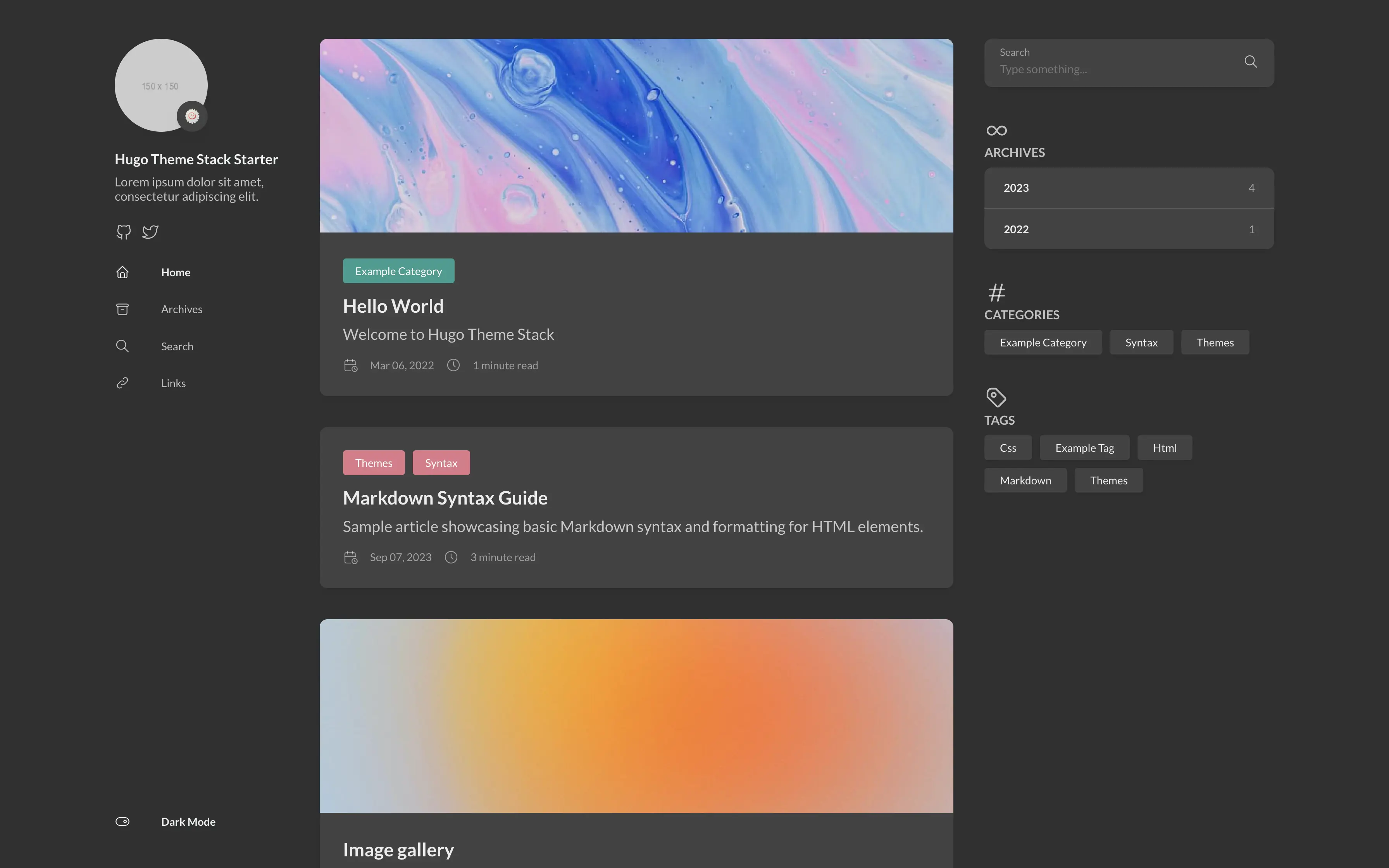
-
在網站的根目錄中打開終端機,利用
git submodule將主題下載至themes資料夾中:1git submodule add https://github.com/CaiJimmy/hugo-theme-stack/ themes/hugo-theme-stack -
刪除
hugo.toml檔案並將themes/hugo-theme-stack中的config.yaml複製到根目錄中,在此檔案的最上方加入以下內容:1 2 3 4 5 6baseurl: https://example.com languageCode: zh-tw theme: hugo-theme-stack pagination: pagerSize: 5 title: <blog_title> -
其他設定可以參考 Stack 官方提供的 Config 依個人喜好修改:
-
網站 icon 設定
將favicon.ico置於static的資料夾中,並在config.yaml修改以下內容:1 2params: favicon: favicon.ico -
側邊欄設定
- 將自己的大頭貼
avatar.webp置於assets/img資料夾中(若無則自行新增),並在config.yaml修改以下內容:1 2 3 4 5 6 7 8 9params: sidebar: compact: false emoji: subtitle: <subtitle> avatar: enabled: true local: true src: img/avatar.webp - 在副標題下方可以加上連結提供導向至自己的 GitHub 等網站,在
config.yaml最下方新增以下內容:1 2 3 4 5 6 7menu: social: - identifier: github name: GitHub url: <github_link> params: icon: brand-github - 若要新增導覽列則可參考
themes/hugo-theme-stack/exampleSite中的檔案內容與架構,修改後content資料夾中的檔案架構將如下所示:1 2 3 4 5 6 7 8 9 10 11 12├── _index.md ├── categories ├── page │ ├── about │ │ └── index.md │ ├── archives │ │ └── index.md │ ├── links │ │ └── index.md │ └── search │ └── index.md └── post
- 將自己的大頭貼
-
文章設定
修改以下config.yaml的內容讓文章可以支援 LaTeX,並加上目錄、閱讀時長、預設 CC 授權等內容:1 2 3 4 5 6 7 8params: article: math: true toc: true readingTime: true license: enabled: true default: CC BY-NC-SA 4.0 -
留言設定
-
至 Disqus 建立新帳戶,並創建新的 site,從設定中查詢 shortname。
-
修改以下
config.yaml的內容以增加留言功能(將<shortname>替換為 Disqus 設定中的 shortname):1 2 3 4 5 6 7 8 9 10 11 12disqusShortname: <shortname> params: comments: enabled: true provider: disqus disqusjs: shortname: <shortname> apiUrl: apiKey: admin: adminLabel:
-
-
widget 設定
修改以下config.yaml的內容使主頁及文章中顯示搜尋、目錄等小工具:1 2 3 4 5 6 7 8 9 10 11 12 13params: widgets: homepage: - type: search - type: categories params: limit: 10 - type: tag-cloud params: limit: 10 page: - type: search - type: toc -
zh-tw 用詞設定
將themes/hugo-theme-stack/i18n中的zh-tw.yaml複製到i18n資料夾中,並依需求更改:1 2 3 4toggleMenu: other: 切換選單 darkMode: other: 深色模式
-
撰寫文章
Hugo 需要使用 Markdown 語法來撰寫文章,這裡採用的方法是為每篇文章都建立一個資料夾,以方便整理資源。
-
在
content/post的資料夾中新增一個以新文章名稱命名的資料夾(盡量使用英文,字與字間不要有空格)。 -
在資料夾中新增
index.md的檔案,content/post資料夾中的檔案架構如下所示:1 2 3 4├── myPost │ └── index.md └── myPost2 └── index.md -
利用 Visual Studio Code 等文字編輯器編輯
index.md,以下為基本的檔案內容(除文章屬性架構外皆可進行修改):1 2 3 4 5 6 7 8 9 10 11 12 13 14--- title: myPost slug: my-post date: 2024-05-20 description: My first post categories: - Blog tags: - First --- ## Hugo Blog content
預覽 Hugo 網頁
透過內建的網頁即時預覽功能,可以讓我們了解網頁目前的內容。
- 在終端機中輸入以下指令:
1hugo server -D - 若網頁沒有錯誤,終端機會顯示以下內容:
1 2 3 4Serving pages from disk Running in Fast Render Mode. For full rebuilds on change: hugo server --disableFastRender Web Server is available at http://localhost:1313/ (bind address 127.0.0.1) Press Ctrl+C to stop - 在瀏覽器中連上
http://localhost:1313/即可預覽目前的網頁。
推送至 GitHub
為了接下來的網頁部署,需要將剛剛所生成的網頁推送到 GitHub 上,具體步驟如下:
- 在 GitHub 上新開一個儲存庫,並將權限設為私人(Private),其餘設定皆保持原狀。
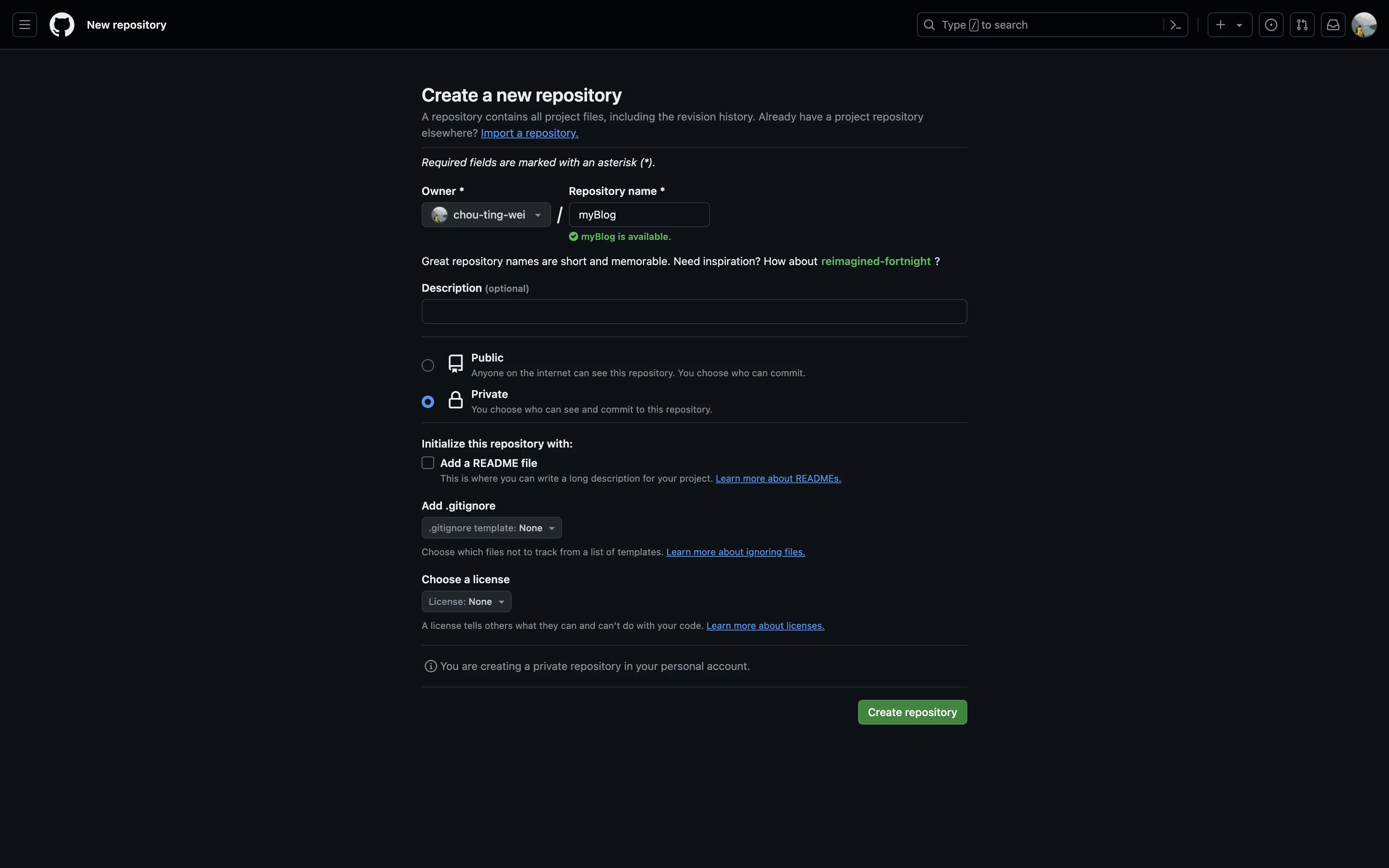
- 在根目錄中建立
.gitignore檔案,檔案內容如下:1 2 3 4public resources assets/jsconfig.json .hugo_build.lock - 複製頁面上儲存庫的網址
https://github.com/xxx/xxx.git,並在根目錄中執行以下指令(<repo_link>需替換成儲存庫的網址),將全部檔案推送到 GitHub 儲存庫中:1 2 3 4 5git add . git commit -m "first commit" git branch -M main git remote add origin <repo_link> git push -u origin main
Vercel
Vercel 是一個提供網頁的託管服務的平台,類似於 GitHub Pages 但更為強大、快速。另外 Vercel 也可以在有新的 Git 推送時自動化部署新的網頁,並每月提供 100GB 的免費流量,對小型網站架設是一大福音。下方表格為幾個常見網頁託管平台的比較:
| 功能 | Vercel | Netlify | GitHub Pages |
|---|---|---|---|
| 最適用於 | Next.js 應用 | 靜態網站 | 靜態網站 |
| 部署來源 | GitHub、GitLab、Bitbucket | GitHub、GitLab、Bitbucket | 僅限 GitHub |
| 建構速度 | 極快 | 快 | 較慢 |
| 頻寬限制 | 每月 100GB(免費方案) | 每月 100GB(免費方案) | 無限制 |
| 可靠性保證 | 99.99% | 99.99% | 無 |
| 分析工具 | 內建 | 內建 | 無 |
部署網站
- 至 Vercel 官網以 GitHub 登入。
- 選擇
Add New >> Project,並於左側列表選擇剛剛設定好的 Git Repository。 - 將
Framework Preset設為Hugo,並點擊展開Environment Variables加入HUGO_VERSION與本地端使用的版本(可使用hugo version指令查詢):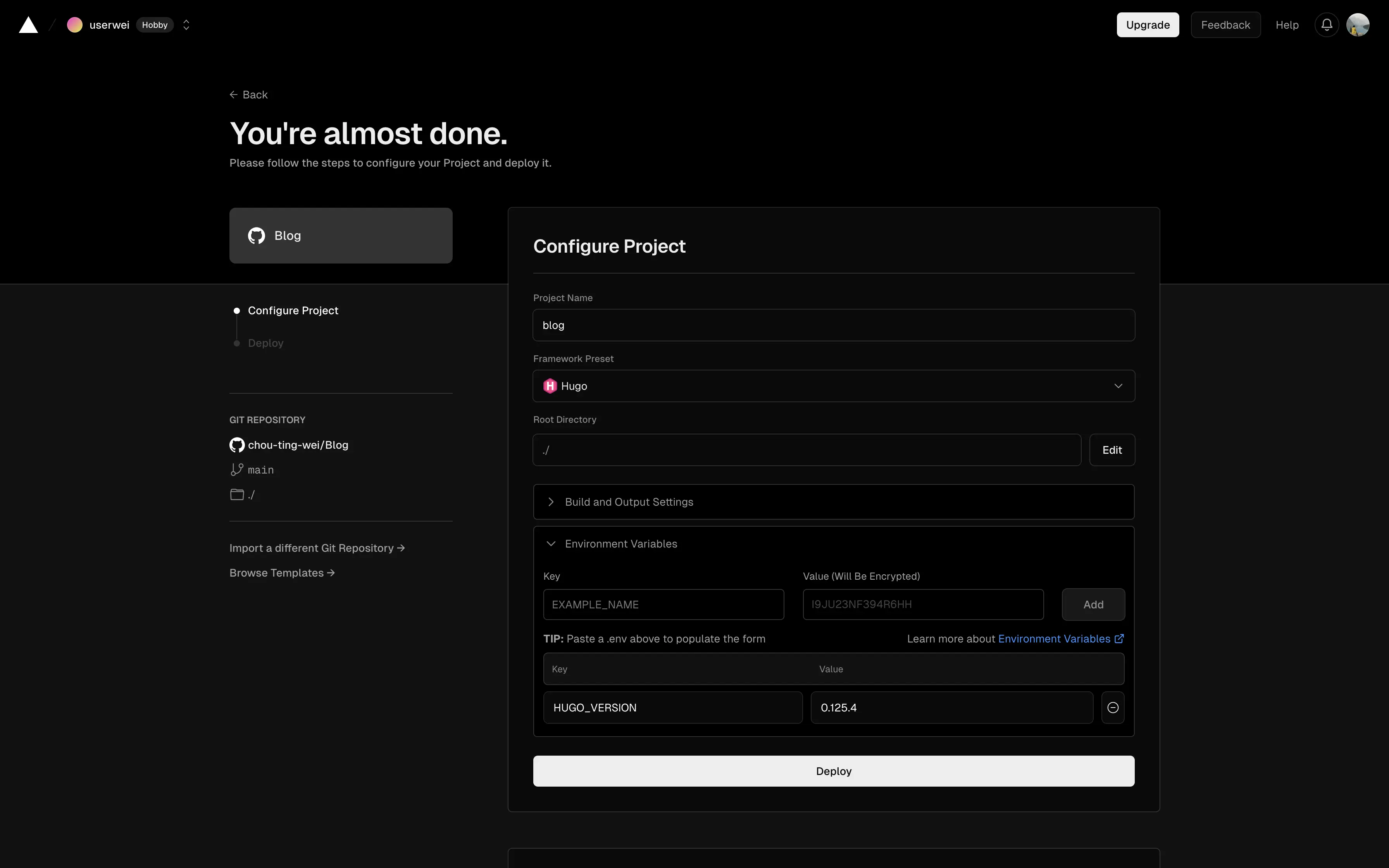
- 若看到以下畫面即完成網頁的部署。
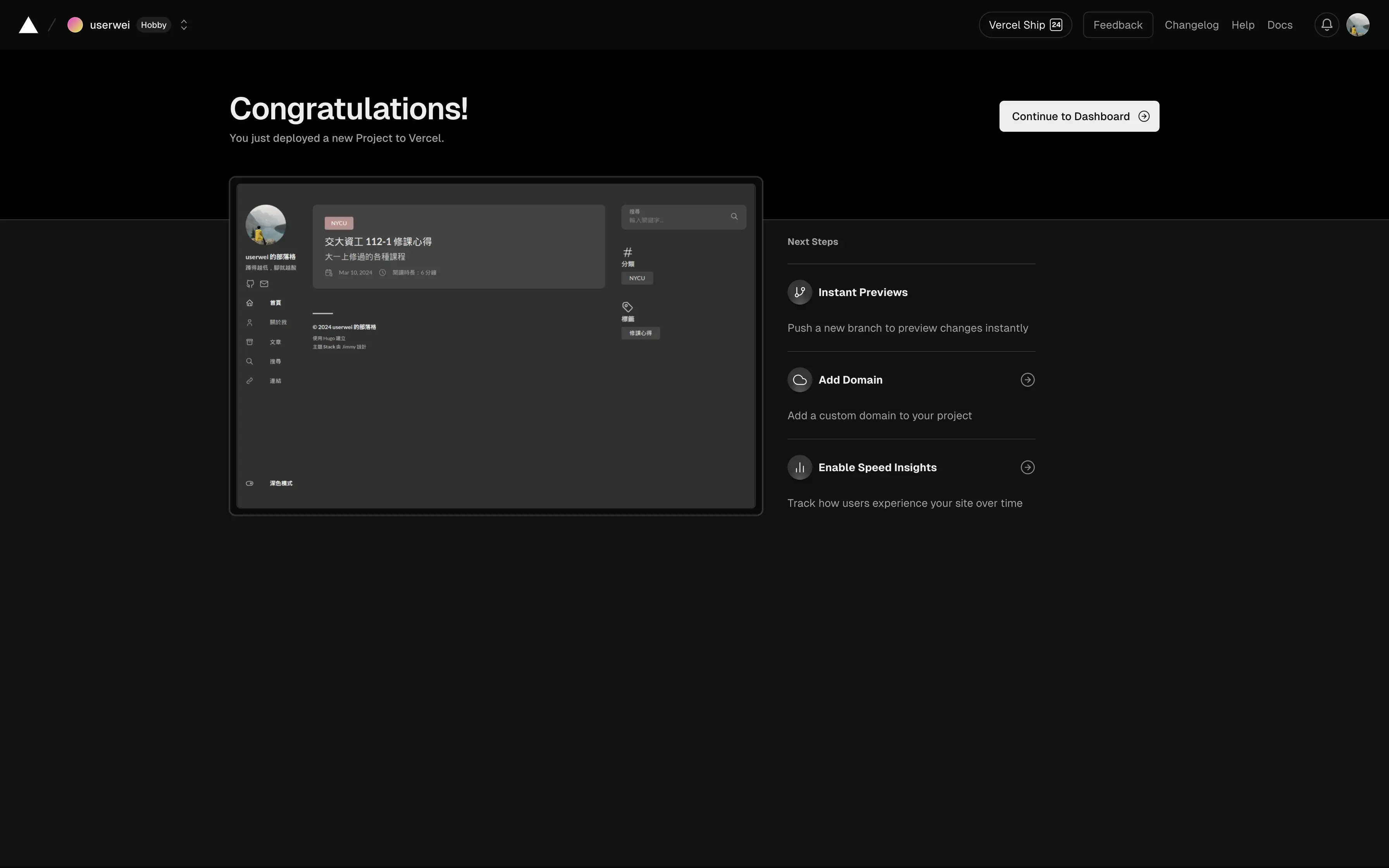
連結域名
在後台中可以看到 Vercel 為剛剛部署的網頁提供了一個 xxx.vercel.app 網址,如果想更改為其他的自訂網址,則需要自行取得並連結域名。
- 從 Cloudflare、Namecheap、GoDaddy 等網域註冊商取得一個域名。
- 將
config.yaml中的baseurl更改為取得的域名https://www.xxx.com:1baseurl: <domain_name> - 進入後台
Settings >> Domains加入取得的域名,選擇推薦的加入方式。加入後會顯示以下畫面: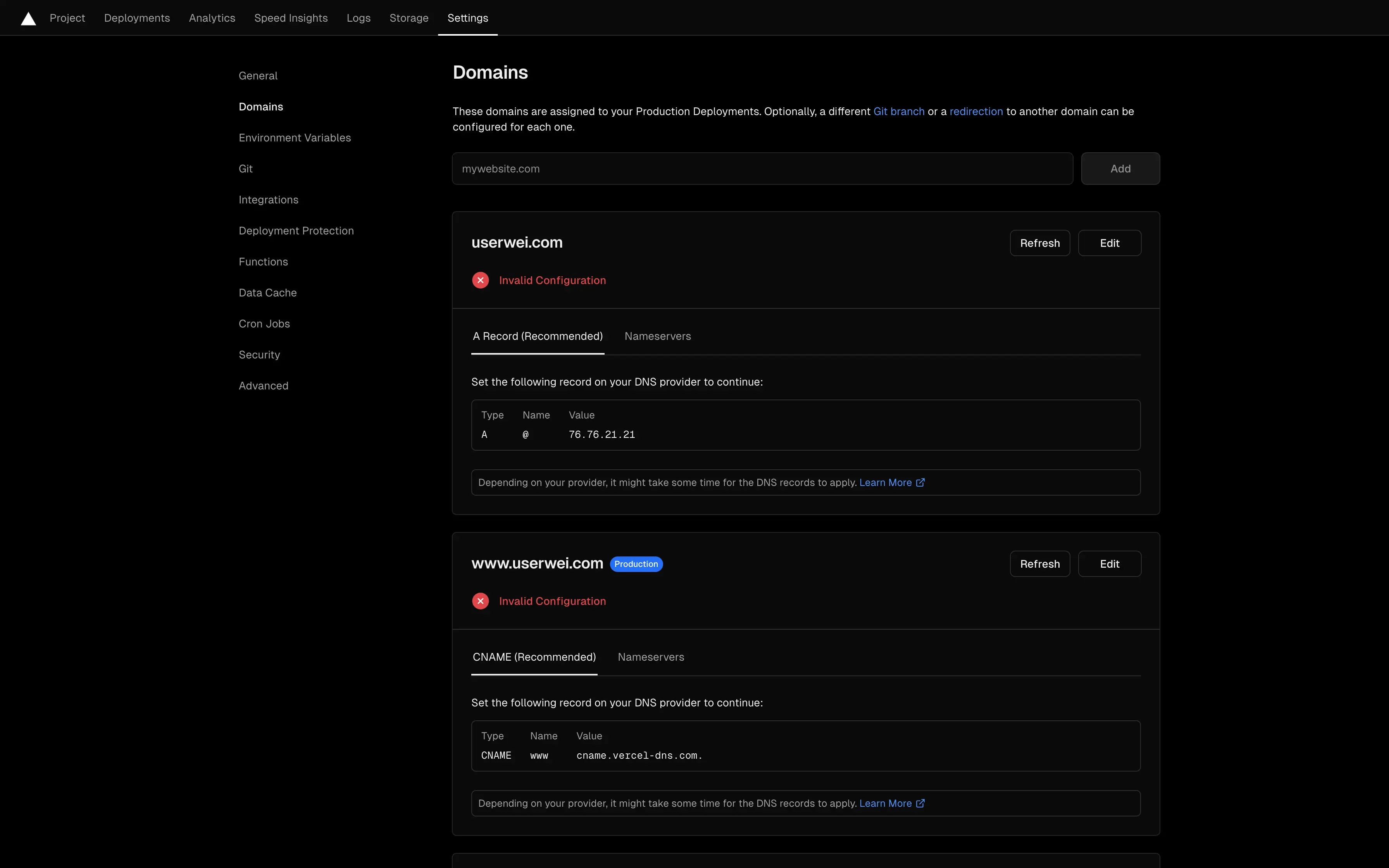
- 依照指示至網域註冊商設定 DNS:
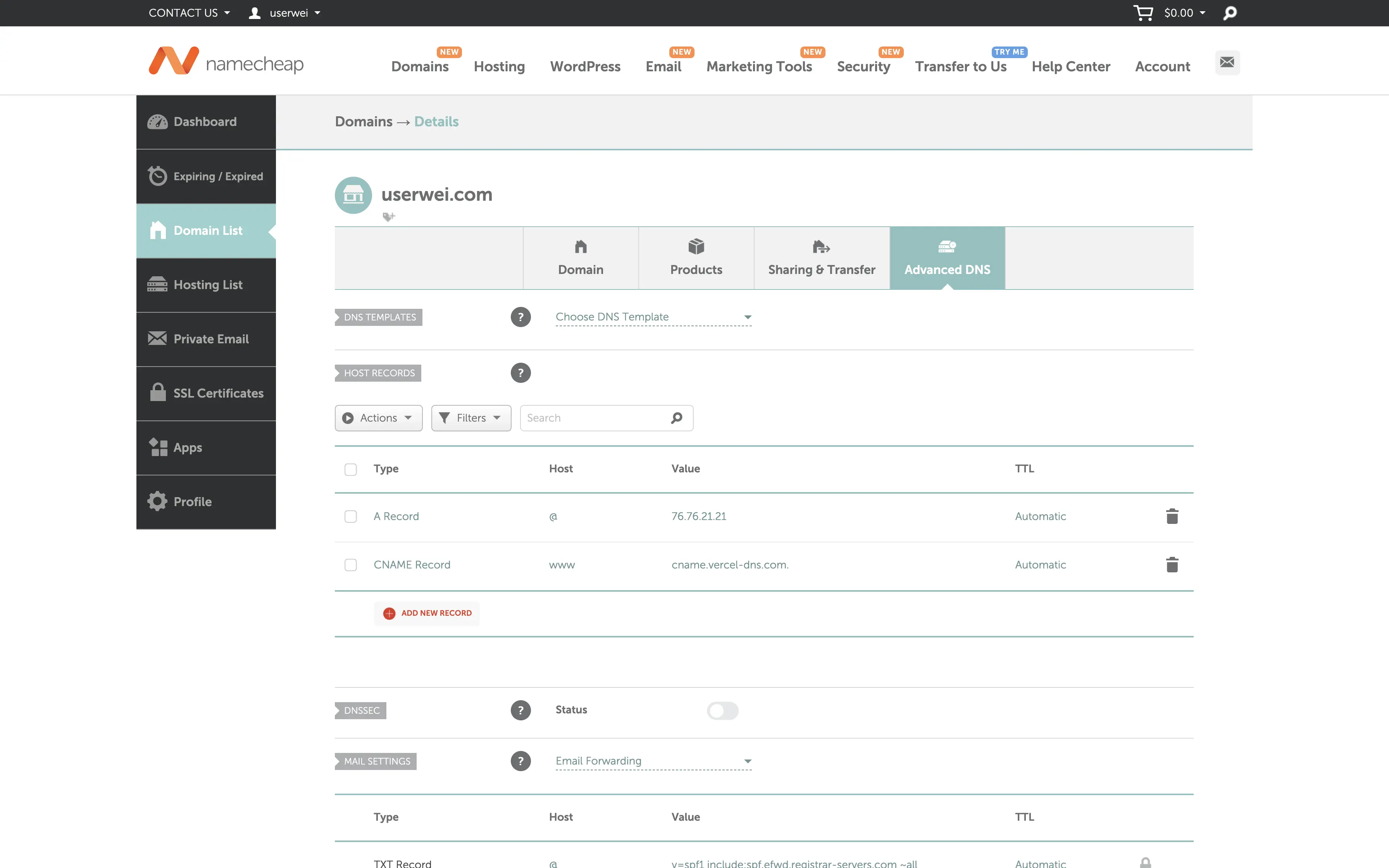
- 回到後台重整後,看到域名的設定都配置成功即完成設置:
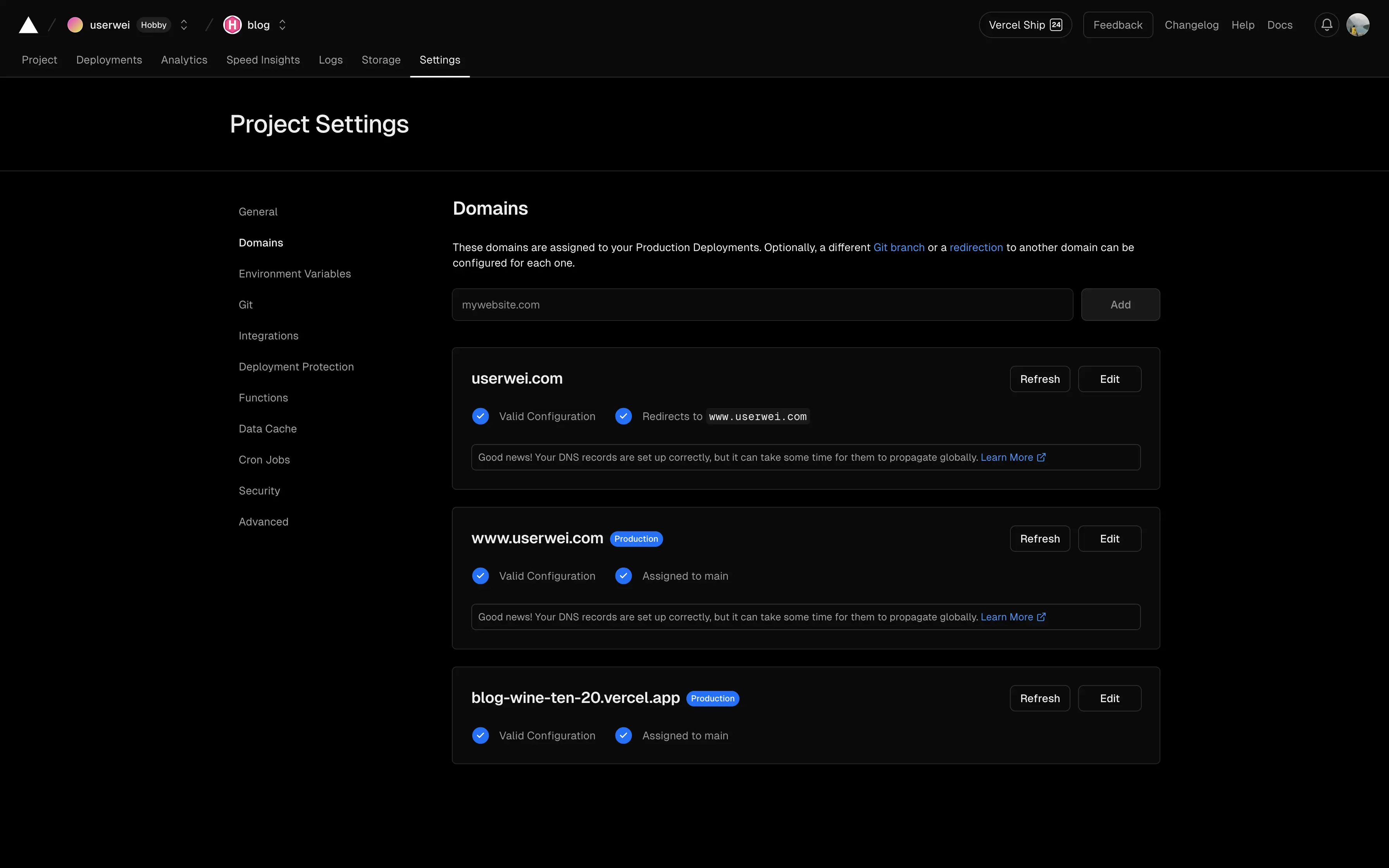
網頁分析設定
在 Vercel 後台的導覽列上可以找到 Analytics 與 Speed Insights 的選項,可以用來了解目前網頁的成效。
- 在後台分別同意使用這兩種網頁分析,完成會顯示幾段程式碼需要加入自己的網頁中。
- 於
layouts資料夾中新增_default資料夾。 - 從
themes/hugo-theme-stack/layouts/_default中複製baseof.html至剛剛新增的layouts/_default資料夾,檔案架構如下所示:1 2 3└── layouts └── _default └── baseof.html - 在
baseof.html的<body>區塊中新增以下程式碼:1 2 3 4 5 6 7 8 9 10 11 12 13 14 15 16<script> window.si = window.si || function () { (window.siq = window.siq || []).push(arguments); }; </script> <script defer src="/_vercel/speed-insights/script.js"></script> <script> window.va = window.va || function () { (window.vaq = window.vaq || []).push(arguments); }; </script> <script defer src="/_vercel/insights/script.js"></script>⚠️注意: 請不要替換此部分的
<>。 - 將更新後的網站 push 至 GitHub,重整 Vercel 後台即可查看網頁分析。
Google Search Console
Google Search Console 是由 Google 開發的 SEO 工具,可以提供網站所有者了解索引狀況、搜尋流量等資訊,進而優化網頁的搜索排名。
新增網頁資源
- 登入 Google Search Console 後選擇新增資源,輸入自己取得的域名:
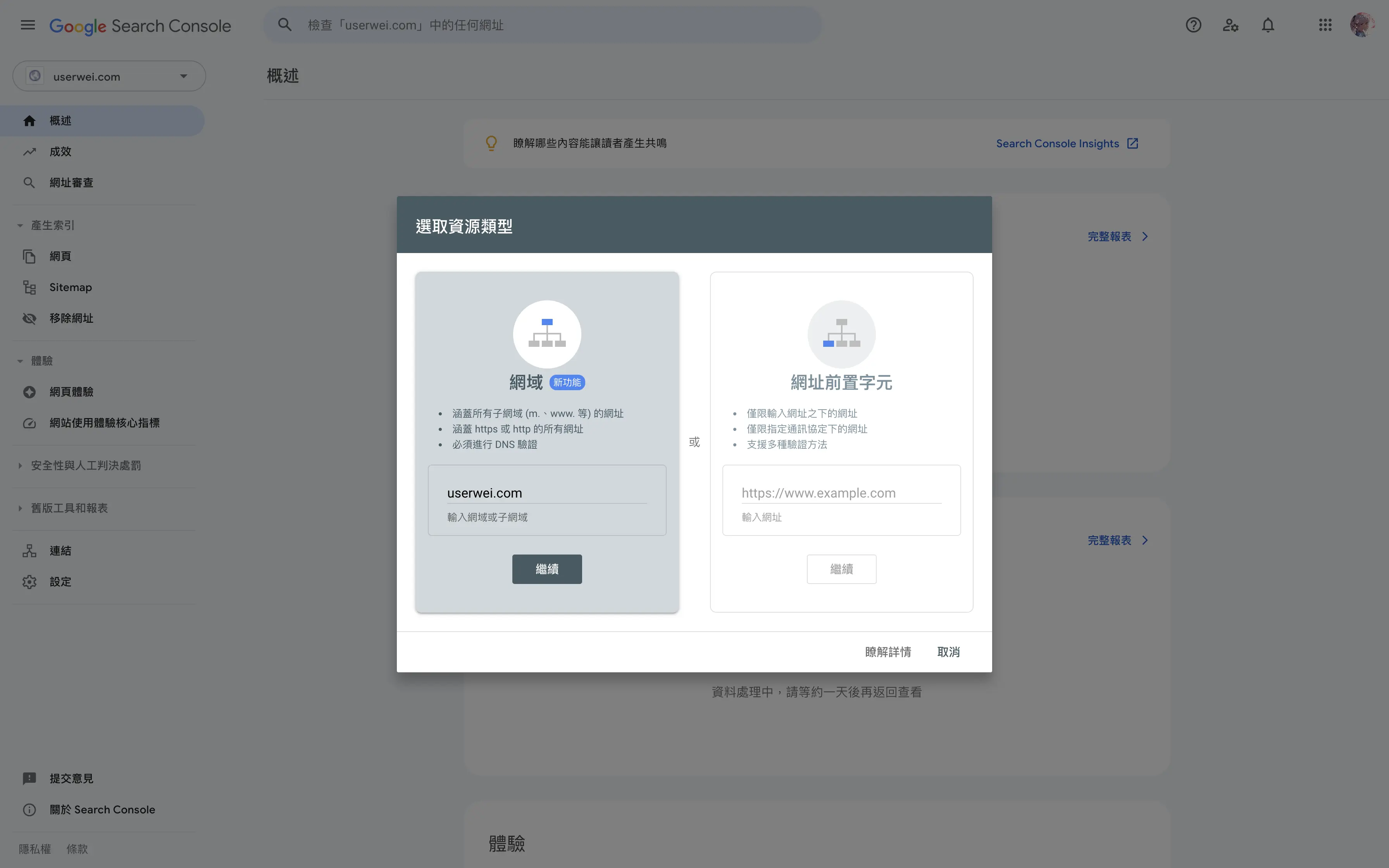
- 在網域註冊商的 DNS 中加上 Google 提供的驗證代碼
google-site-verification=xxx: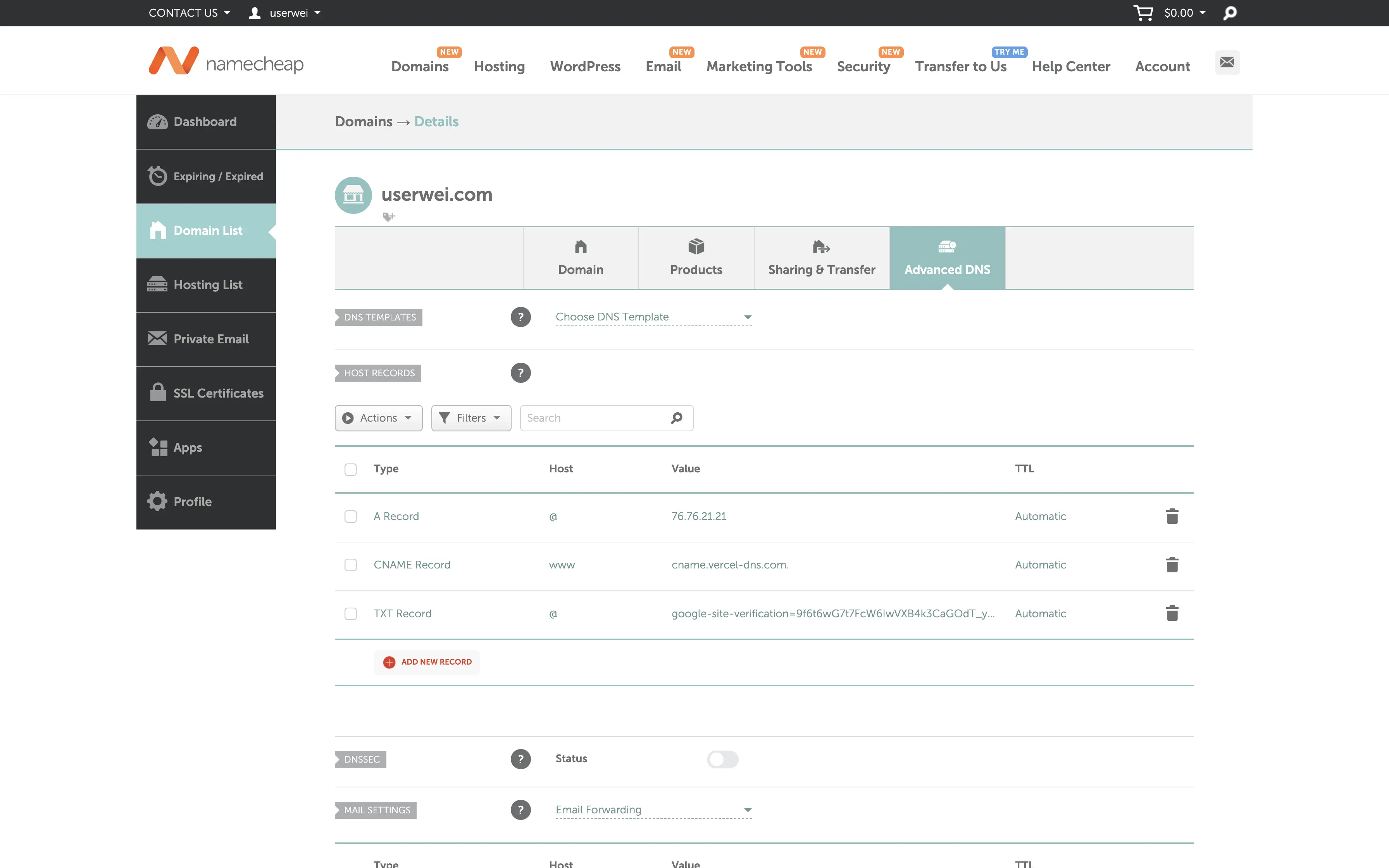
- 等待所有權驗證成功後即可使用。
Sitemap 設定
Sitemap 是一種網頁導覽的檔案,它記載所有網頁的連結與架構,讓搜尋引擎能快速理解網站內容架構,其中用途最廣泛的為 XML Sitemap。
- 在
config.yaml中新增以下設定使網頁自動產生sitemap.xml:1 2 3 4 5sitemap: changeFreq: "" disable: false filename: sitemap.xml priority: -1 - 將更新後的網站 push 至 GitHub,等待 Vercel 重新建置網頁。
- 在 Google Search Console 的後台側邊欄選取
Sitemap並新增https://www.xxx.com/sitemap.xml。 - 提交後狀態顯示成功即完成設定。
Robots.txt 設定
Robots.txt 是提供給機器人的一組指令,主要是管理網路爬蟲的活動,能夠告訴搜尋引擎檢索器可以存取網站上的哪些網址。
-
在
static資料夾中新增robots.txt,內容如下:1 2 3 4User-agent: * Disallow: Sitemap: https://example.com/sitemap.xml -
Disallow 的部分可依個人需求自行增加,這邊簡單舉幾個例子:
1 2 3Disallow: /page/ Disallow: /page/search/ Disallow: /categories/ -
等待 Google Search Console 自行檢索,可在
設定 >> robots.txt中查看,若顯示已擷取即完成設定。